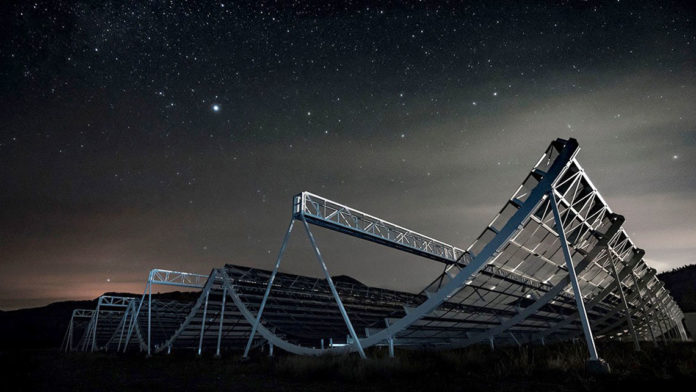Five years ago, Canadian scientists placed a $16M bet that by the time they finished building their new state-of-the-art radio telescope, the computing power would be available to allow them to use it.
And last week, just as they had hoped, the last piece was installed with a real-time processor to match. By continuously mapping more of the sky than previously possible, this project will revolutionize our understanding of the universe.
CHIME, the Canadian Hydrogen Intensity Mapping Experiment, is unlike most telescopes that swivel to narrowly focus on a precise object in the night sky. Instead, its array of four semi-cylindrical reflectors, each 20 metres across and 100 metres long and lined with 256 dual-polarization antennas, has almost no moving parts but will map an arc that spans over half the sky each day.
This special collaboration brings together researchers from institutions across Canada and the world, including the University of British Columbia, the University of Toronto, McGill University, the Perimeter Institute, and the National Research Council of Canada.
Looking more like a collection of snowboarding half-pipes than a telescope, CHIME measures in the radio band. Because this is part of the electromagnetic spectrum with wavelengths much longer than visible light, daylight doesn’t interfere with measurements, allowing CHIME to collect information both day and night. CHIME scans over a stripe of the sky from northern horizon to southern horizon, and sweeping over a broad arc as it rotates with the Earth each day.
To image so much of the sky in real time, 1,024 processors are working in tandem to churn through over a terabyte of data every second, generating a 3D map of outer space. For context, this rate of incoming data is equivalent to the volume of information flowing through the entire world’s mobile data network.
Poised not only to look deeply into the outer edges of space, CHIME will also probe into mysteries of the early universe; the light from very distant objects is actually a window back in time, as that light has traveled for so long just to reach the Earth. CHIME will image objects as distant as 7 to 11 billion light years from Earth.
CHIME will look for the signature radio signals from the universe’s smallest element, hydrogen. These signals can be used to calculate position and distance, giving a 3D map of the galaxies and the web of hydrogen between them. Each day, the same areas of the sky will be observed again, allowing researchers to see how positions change over time.
This will give vital information on the accelerating expansion of the universe, and how dark matter and dark energy are driving this acceleration.
CHIME will also zero in on fast radio bursts, a phenomenon that only lasts for a few milliseconds. Since their discovery in 2007, only around 30 of these bursts have been observed, but scientists hope that CHIME will be able to find several each day. Fast radio bursts are as yet unexplained, but they may be generated by rapidly spinning neutron stars called pulsars.
Hundreds of pulsars will be monitored by CHIME, which emit radio signals at highly precise intervals. Any changes in the timing of these pulses could help scientists visualize passing gravitational waves: ripples in space-time caused by the collision of massive objects, like black holes.
Thanks for foresight and ambition, this remarkable project is already upping the ante on some of the deepest and most pressing mysteries in physics and astronomy. No matter what CHIME finds, it’s sure to illuminate the universe in a new way.




































